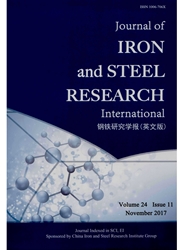

 中文摘要:
中文摘要:
A multi-objective optimization model for draft scheduling of hot strip mill was presented,which considers rolling power minimizing,rolling force ratio distribution and good strip shape as the objective functions.A multi-objective differential evolution algorithm based on decomposition (MODE/D) was used to solve this model.The two-objective and three-objective optimization experiments were performed respectively to demonstrate the optimal solutions of trade-off.The simulation results show that MODE/D can obtain a good Pareto-optimal front,which suggests a series of alternative solutions to draft scheduling.The extreme Pareto solutions are found feasible and the centres of the Pareto fronts give a good compromise.The conflict exists between each two ones of three objectives.The final optimal solution is selected from the Pareto-optimal front by the importance of objectives,and it can achieve a better performance in all objective dimensions than the empirical solutions.Finally,the practical application cases confirm the feasibility of the multi-objective approach,and the optimal solutions can gain a better rolling stability than the empirical solutions,and strip flatness decreases from (0±163) IU to (0±45) IU in industrial production.
 英文摘要:
英文摘要:
A multi-objective optimization model for draft scheduling of hot strip mill was presented, rolling power minimizing, rolling force ratio distribution and good strip shape as the objective functions. A multi-objective differential evolution algorithm based on decomposition (MODE/D). The two-objective and three-objective optimization experiments were performed respectively to demonstrate the optimal solutions of trade-off. The simulation results show that MODE/D can obtain a good Pareto-optimal front, which suggests a series of alternative solutions to draft scheduling. The extreme Pareto solutions are found feasible and the centres of the Pareto fronts give a good compromise. The conflict exists between each two ones of three objectives. The final optimal solution is selected from the Pareto-optimal front by the importance of objectives, and it can achieve a better performance in all objective dimensions than the empirical solutions. Finally, the practical application cases confirm the feasibility of the multi-objective approach, and the optimal solutions can gain a better rolling stability than the empirical solutions, and strip flatness decreases from (0± 63) IU to (0±45) IU in industrial production.
 同期刊论文项目
同期刊论文项目
 同项目期刊论文
同项目期刊论文
 Factors affecting temperature distribution along thickness of plate during cooling process and their
Factors affecting temperature distribution along thickness of plate during cooling process and their 期刊信息
期刊信息
